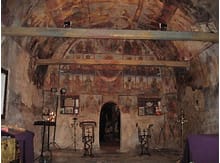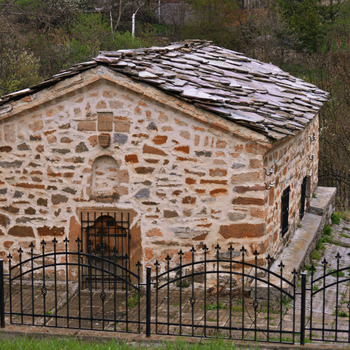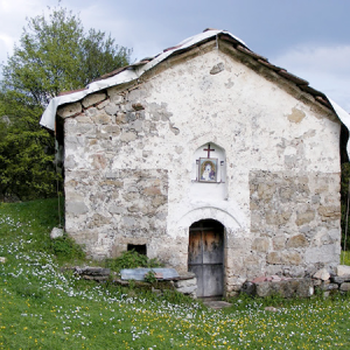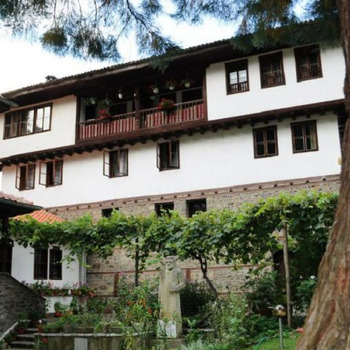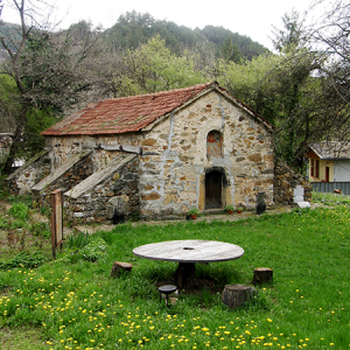MEDIEVAL CHURCH OF THE Dormition of the Mother of God
Overview
The Iskretsi Monastery of the Assumption is located within the boundaries of the Sanatorium for Lung Diseases "King Ferdinand I". The Sanatorium itself was established in 1908 by decree and donation of Tsar Ferdinand, and the Holy Synod of the Bulgarian Orthodox Church donated the lands of the monastery for its construction. In this way the monastery church turned out to be an internal building for the territory of the sanatorium.
It is believed that the monastery existed in the XIII century. It belongs to the Sofia (Mala) Sveta Gora (Sredetska Mala Sveta Gora), which during the Second Bulgarian Kingdom included 14 monasteries around Sofia. Probably the monastery was part of a large complex, including fortresses and several churches, as evidenced by the findings of stone columns and the foundations of a large, probably Metropolitan Church in the area of "White Cross". Legend has it that this first monastery was destroyed very early - when the Turks came in the XIV century.
At the beginning of the 17th century, a church was rebuilt on this place, as evidenced by a donor inscription from 1602. The church was single-nave, built of quarry stones, with modest dimensions of 5.8 x 3.8 m, but 0.75 m thick walls. Inside the temple, there is a large round stone with an inscription. At that time the church was painted. Some legends connect these first frescoes with the activity of Pimen Zografski (1540-1620), who is known to have restored and painted many churches and monasteries in the Sofia region at the end of the 16th and the beginning of the 17th century. In any case, these first frescoes were erased during the re-painting of the church in the 19th century, and currently only the fallen plaster on the north wall of the early church reveals a small detail of this artistic richness.
This first building was repainted in 1845, when the church was extended from the west with a spacious narthex (10 x 7.40 m). Above the entrance to the early church is an inscription from which it is understood that the restored church "was depicted during the time of the monk and abbot Marinko Epitrop, summer 1845". Other inscriptions, already in the newly built narthex, testify to donations from the local population.
The new painting of the church covers the old frescoes of the early building, as well as the newly built narthex. In the nave in quadrangular frames are presented three types of images of Christ: Christ Almighty (Pantocrator), Christ Emmanuel and Christ the Angel. On the east wall in the conch of the apse are depicted the Mother of God with the archangels Michael and Gabriel. Above the apse, in the vault - "Pentecost". Below the image of the Mother of God are the scenes "The Communion of the Apostles" and "Melismos". The murals also depict traditional saints and Old Testament prophets. In the Last Supper scene, Christ holds the so-called "acacia" (a bag of dust, a symbol of transitory earthly life), a detail found mainly in images of emperors.
Scenes from the earthly life of Christ are depicted on the north and south walls on two levels in chronological order. The cycle is characterized by a desire for completeness and a sense of detail. The "Passions of Christ" are presented in the most detailed way. Two friezes of medallions depict the Old Testament prophets (above) and the saints (below). The west wall is filled with the scenes "Transfiguration" and "Assumption". The lower part of the walls is occupied by the cycle of the Mother of God, and at the bottom are depicted eight images of women saints (Elisaveta, Anna and the Bulgarian St. Petka).
The porch depicts the Miracles of Christ and life cycles of St. George the Victorious, St. Nikola Chudotvorets, Ivan Rilski. There are 13 scenes illustrating the Revelation of John the Theologian - such a richly illustrated Apocalypse is witnessed only in the Rila Monastery. On the east wall of the porch is a Virgin Mary, surrounded by 21 saints.
Some researchers suggest that the frescoes in the Iskretsi Monastery were created under the influence of those in the Rila Monastery. According to A. Vassilev, their author (as well as the frescoes in the Baptismal font) is Yanachko Stanimirov from the village of Breze. D. Kamenova connects them with the painter Kiriak from Sofia region.
South of the temple is a 7-wall Baptistery-Confession. This building is the only independent Baptistery of its kind, built in a Bulgarian monastery. At the time of its construction there are two versions: in the XVIII century, according to a poorly preserved inscription, and in 1856 - according to an inscription in a niche in the window. According to its architectural features, the construction of this building can be attributed to the middle of the XIX century. In the center of the Baptistery is preserved the stone font. Its inner walls are completely decorated with frescoes, in which the image of the Mother of God predominates.
At the same time (in the XIX century) the monastery complex was restored, consisting of two-storey buildings with verandas. Currently, only the entrance gate of this complex is preserved. Towards the end of the 19th century there was a cell school here.
An engraved Psalter, printed in Venice in the 16th century (currently in the library of the Holy Synod), originates from the Iskretsi Monastery. A file in it reports the ruin of Sofia by a detachment of Kurdzhali, led by Kara Feizi in the early 19th century.
During the Communist period (1944-1989) the church was closed. However, residents of the village of Iskrets came here and lit candles. The first service after the fall of the regime was held on September 8, 1991 in honor of the Nativity of the Virgin. Many believers come here on this holiday and especially on the temple - Assumption (August 15). The temple serves only major Christian holidays.
Recommended
- Dushnika Cave
- Iskrets karst springs - Iskrets
- Dobravishka Skaklya Waterfall - Dobravitsa


 Bulgarian
Bulgarian Romanian
Romanian